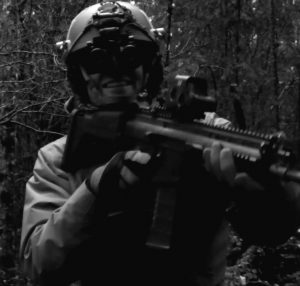ATN PS31 NVG Review
- Adjustable Eye Spacing
- 50* Field of View (normal NVG only have 40*)
- Adjustable Focus & Diopter
- Cost 40%-70% less than PVS31 BNVD, depending on which tubes are selected
- Automatic Gain Control
- Built-in IR illuminator
- One or both tubes can be rotated up & out of the wearer’s line of sight
- Each tube automatically shuts off independently when rotated up
Basic Features:

The ATN PS31 is a polymer BNVD housing made by ATN Corp that has adjustable eye spacing. While similar looking to the much more expensive PVS31, ATN’s entry into the dual tube market has some notable differences. The PS31 comes with a built-in IR illuminator, adjustable diopter and also has an automatic gain, unlike the PVS31. Of course, these features make the ATN unit weigh a bit more.
PS31: First Impressions
I love the ATN PS31-3w’s image clarity and I also appreciate the easy-to-use controls. I also like the unit’s “wide angle” 50 degree field of view. Is this unit “just as good” as units shipped with higher grade tubes? No But, just because it’s not “just as good” doesn’t mean that it’s bad. As a value proposition of performance for the money, I’m extremely happy with the PS31. It’s worth noting that the unit did not ship with a specification sheet for the exact tubes included. Also frustrating, ATN’s website has generic information that does not seem to reflect the exact details of the different intensifier tubes offered. That said, the price of the gen 3 white phosphor version seem to be in keeping with other housings fitted with L3 Harris thin film tubes. After about 4 months of ownership, I still can’t see any blemishes on either tube.
On the whole, I’m very happy with my purchase and so far I’m happy with the quality of the NVG. Can you get better tubes that ship with spec sheets? I’m sure you could. Then again, those websites seem to charge more. Some of the accessories, like the “G24” mount, seem poorly made and/or a bit out of spec. Can these compete with L3 filmless “pinnacle” tubes? No. On the other hand, these BNVG range in price from about $4,000-$7,000 as opposed to over $12,000+ for top shelf dual tubes.
- Gen 2 Green Phosphor
- The PS31-2 unit comes in at an MSRP around $4,295-, $3,999.99 street price. This represents a strong value and an affordable way to get into a decent set of “budget” dual tubes, if price is your primary concern.
- Gen 2 White Phosphor:
- The PS31-WPT has an MSRP of $4,795-, $4,499.99 street price. The WPT version has Photonis Echo Gen 2 White Phosphor tubes. The Photonis Echo is considered by some to be a Gen 2+ and one of the affordable ways to get into white phosphorous tubes. YouTube creator
Hoplopfheil has a good video on these tubes. However, some say that Photonis tubes sold by ATN may not be top rated examples. - Gen 3 Green Phosphor:
- The PS31-3 has an MSRP of $6,495-, $5,999.99 street price. The PS31-3 is ATN’s Gen 3 Green Phosphor model. I believe it has an intensifier tube constructed by Elbit Systems, but I’m not positive about this.
- Gen 3 White Phosphor:
- The PS31-3W has an MSRP of $7,495-, $6,999.99 street price. It comes with L3 Harris thin film white phosphorus tubes.
ATN PS31 Intensifier Tube Options
Diopter, Gain & Focus
The ATN PS31 features adjustable diopter, manual focus and automatic gain control. Adjustable diopter means that the image can be adjusted to correct for variations in human vision in the same way that prescription glasses do. For a unit to be used by civilians, this feature makes sense. Using the diopter, I can more easily let friends try out the NVG, adjusting it to better match each wearer’s eyes. I can see why it makes sense for PVS31’s to eschew adjustable diopter, because it saves a few ounces and spec ops commandos can simply have the diopter set at the factory.
I have some mixed feelings about the automatic gain control. I appreciate the fact that automatic gain makes it simple to go from well-lit areas to total darkness. I can wear the device and walk into a fully lit home, step out the door into a very dark night and just keep on moving, no adjustment required. On nights with strong moonlight, open areas are extremely well lit, which causes the unit to reduce its light sensitivity. On nights like that, manual gain control might allow me to fine tune the device to optimize them for scanning shadows and dark thickets. Night vision is full of trade-offs.
The manual focus also comes with trade-offs, but it still seems like the right move. Being a complex optical device, night vision goggles need to be focused. While wearing the device, if you focus on objects at 10-25 yards away, objects within arms reach will appear blurry. If you focus on objects that are under 10 feet away, further away scenery will be out of focus. I normally focus about 25-30 yards away and just deal with my rifle being blurry. In a perfect world, everything would be in perfect focus all the time. But in the real world, automatic focus is another complex feature that can easily break and it also involves software trying to guess what the most important part of the image is.
Size & Weight:
- PVS31 weight:
- 490g, 17.28oz w/ 1 AA
- PS31 weight:
- 596g, 21.02oz w/ 1 CR123
The ATN PS31 is reasonably lightweight at 21 ounces. By comparison, the much more expensive PVS31 weighs about 17 ounces. Light weight is very important when you’re hanging goggles off the front of a helmet and wearing them for several hours. Of course, the PVS31 achieves its lighter weight by removing features like adjustable diopter. Of course, if you opt for the PVS31 over the PS31, your wallet will also be significantly lighter too. The size of this NVG is very similar in form factor to the PVS31 as well.
ATN lists this BNVG dimensions as 4.5″ length, 7.0″ width (fully extended), 3.4″ tall. While I haven’t confirmed these measurements, they seem about right.
Performance & Durability:
I’ve had the PS31 for about 3 months so far and up to this point and I’ve used them in a variety of weather conditions. With the exception of the knockoff G24 mount that ATN included, I’ve been very satisfied with the durability of the NVG. So far, I’ve used the goggles in autumn and winter conditions common to the pacific northwest mountains. I’ve worn them for several hours in a continuous near-freezing rain-storm as well as blizzard conditions. Despite these adverse conditions, the goggles have continued to work flawlessly. Battery usage has also been very modest, which is nice considering that CR123 batteries can be expensive and somewhat hard to find.
I purchased the gen 3 white phosphorous version, so my comments about image quality are reflective of that. I’ve looked through Gen 2 Photonis Echo tubes and got to compare them to my gen 3, and the gen 3 are far and away superior in terms of light amplification, image quality and resolution. That said, the Photonis Echo tube seemed to have enough clarity and resolution to be very useful and definitely much more modestly priced.
Most of my use has been in very rural environments with little to no man-made lights.
In a driving rain storm under heavy cloud cover with no moon and a thick canopy of trees, the shadows deepen to the point that animals (or people wearing camouflage) could hide from someone wearing these in the shadows of thickets. Despite this, the wearer can still see well enough to walk around and navigate obstacles without using the IR illumination. In such stormy conditions with no snow cover and no artificial illumination, expect the image to appear grainy and dim. On the other side, with even the tiniest amount of moonlight, even if obscured by clouds, expect the image quality to improve exponentially. On a clear night with stars and a crescent moon, the scene is absolutely stunning.
Are Dual Tubes Worth It?
The answer to this question depends on your budget and what you want to accomplish. For moving around quickly at night, dual tubes are totally worth it. On the other hand, if you’re mainly wanting to use your NVG for static observation, surveillance or on a budget, then a single tube system may be the way to go. For me personally, I strongly prefer dual tubes for most applications.
“G24” Mount Included
ATN shipped the device with a helmet mount along with a G24-style mount. But, the excessive free-play in the G-24 mount that came with mine leads me to believe that it’s a knockoff, not a real Wilcox. I suppose it’s nice that I had one less thing to immediately purchase, but it the excessive free-play of mount was dissapointing. Out of the box, the mount included with the unit had so much free-play that the NVG were almost useless for anything but walking around in the backyard. The knockoff G24 has tension screws that can be tightened down to limit the floppiness, but doing so makes the flip-up feature and eye-relief adjustment of the mount non-functional. The PAGST-style helmet base-plate seems well-made, but I haven’t used it much. After tightening down the tension screws on the knockoff G24, it does a passable job of stabilizing the goggles so long as you don’t want to use the mount to flip them up. As an alternative, I flip the tubes up and out of the way in the “gullwing” fashion when I need them out of the way. Over-all, it might make sense to use the included mount to get started, but if you’re already spending real money, you’re going to eventually want a real Wilcox.
Final Thoughts
I’m very happy with the performance per dollar of the PS31 and so far, so good. This unit is an affordable way to get into dual tube night vision goggles and I appreciate the options of various tubes at different price points. I’m very happy with the performance in low light conditions. Having night vision is a game-changer and I’m excited to now “own the night”. In closing, I believe that the ATN PS31 series are the best night vision goggles for the money.
